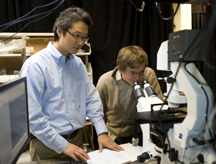New solar cell self-repairs like natural plant systems

Jong Hyun Choi, an assistant professor of mechanical engineering at Purdue, and doctoral student Benjamin Baker use fluorescent imaging to view a carbon nanotube. Their research is aimed at creating a new type of solar cell designed to self-repair like natural photosynthetic systems. The approach might enable researchers to increase the service life and reduce costs for photoelectrochemical cells, which convert sunlight into electricity. (Purdue University photo/Mark Simons)
WEST LAFAYETTE, Ind. - Researchers are creating a new type of solar cell designed to self-repair like natural photosynthetic systems in plants by using carbon nanotubes and DNA, an approach aimed at increasing service life and reducing cost.
"We've created artificial photosystems using optical nanomaterials to harvest solar energy that is converted to electrical power," said Jong Hyun Choi, an assistant professor of mechanical engineering at Purdue University.
The design exploits the unusual electrical properties of structures called single-wall carbon nanotubes, using them as "molecular wires in light harvesting cells," said Choi, whose research group is based at the Birck Nanotechnology and Bindley Bioscience centers at Purdue's Discovery Park.
"I think our approach offers promise for industrialization, but we're still in the basic research stage," he said.
Photoelectrochemical cells convert sunlight into electricity and use an electrolyte - a liquid that conducts electricity - to transport electrons and create the current. The cells contain light-absorbing dyes called chromophores, chlorophyll-like molecules that degrade due to exposure to sunlight.
"The critical disadvantage of conventional photoelectrochemical cells is this degradation," Choi said.
The new technology overcomes this problem just as nature does: by continuously replacing the photo-damaged dyes with new ones.
"This sort of self-regeneration is done in plants every hour," Choi said.
The new concept could make possible an innovative type of photoelectrochemical cell that continues operating at full capacity indefinitely, as long as new chromophores are added.
Findings were detailed in a November presentation during the International Mechanical Engineering Congress and Exhibition in Vancouver. The concept also was unveiled in an online article (https://spie.org/x41475.xml?ArticleID=x41475) featured on the Web site for SPIE, an international society for optics and photonics.
The talk and article were written by Choi, doctoral students Benjamin A. Baker and Tae-Gon Cha, and undergraduate students M. Dane Sauffer and Yujun Wu.
The carbon nanotubes work as a platform to anchor strands of DNA. The DNA is engineered to have specific sequences of building blocks called nucleotides, enabling them to recognize and attach to the chromophores.
"The DNA recognizes the dye molecules, and then the system spontaneously self-assembles," Choi said
When the chromophores are ready to be replaced, they might be removed by using chemical processes or by adding new DNA strands with different nucleotide sequences, kicking off the damaged dye molecules. New chromophores would then be added.
Two elements are critical for the technology to mimic nature's self-repair mechanism: molecular recognition and thermodynamic metastability, or the ability of the system to continuously be dissolved and reassembled.
The research is an extension of work that Choi collaborated on with researchers at the Massachusetts Institute of Technology and the University of Illinois. The earlier work used biological chromophores taken from bacteria, and findings were detailed in a research paper published in November in the journal Nature Chemistry (https://www.nature.com/nchem/journal/v2/n11/abs/nchem.822.html).
However, using natural chromophores is difficult, and they must be harvested and isolated from bacteria, a process that would be expensive to reproduce on an industrial scale, Choi said.
"So instead of using biological chromophores, we want to use synthetic ones made of dyes called porphyrins," he said.
Writer: Emil Venere, 765-494-4709, venere@purdue.edu
Source: Jong Hyun Choi, 765-496-3562, jchoi@purdue.edu
ABSTRACT
Light Harvesting Single-Wall Carbon Nanotube Hybrids
Benjamin A. Baker, Tae-Gon Cha, M. Dane Sauffer, Yujun Wu,
and Jong Hyun Choi
School of Mechanical Engineering, Bindley Bioscience Center,
Birck Nanotechnology Center Purdue University
Due to extraordinary electron accepting and conductivity properties, single-wall carbon nanotubes (SWNT) are explored as molecular wires in light-harvesting cells. Here SWNT are employed as acceptors of photo-excited charge/energy in self-assembling aqueous soluble nanohybrids. DNA oligonucleotides are used as surfactants to solubilize an ensemble of individually dispersed SWNT in water. Water-soluble porphyrins, chlorophyll-like molecules with strong optical signatures in the visible range, are used as donors. A novel structure is developed that employs the oligonucleotides as a multi-functional "glue," simultaneously suspending SWNT while exploiting DNA target recognition capabilities to bind with donor porphyrin. Studies are made on the effects of nucleobase sequence and conformation of the oligonucleotide grafted onto the nanotube, demonstrating sequence based dependence in interaction efficiencies. Based on this sequence and conformation dependence, this structure presents the possibility of easy regeneration of the chromophores by modifying the conformation of the attached oligonucleotide. The various nanohybrids are characterized using a combination of optical, photoelectrochemical and visual techniques. Transductions in absorption spectra and fluorescence quenching show evidence of molecular interactions between porphyrin donor molecules and the nanotubes. Photoelectrochemical measurements provide further evidence of charge transfer interactions between photo-excited porphyrin and SWNT. This hybrid offers a facile manufacturing method for light harvesting nanomaterials, providing a novel pathway for regeneration of photo-degraded dyes in dye-sensitized solar cells.
